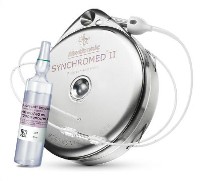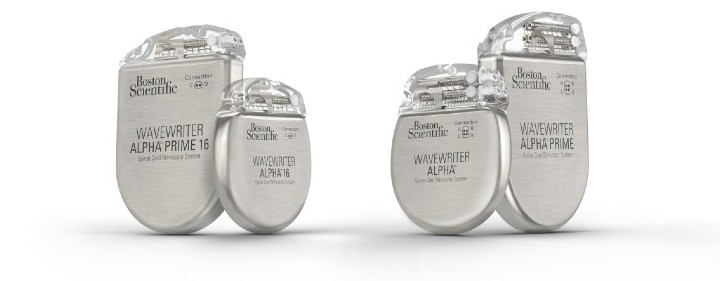Sam Brusco, Associate Editor09.16.22
If oral medications and other conservative strategies have not sufficiently relieved a patient’s chronic pain, implantable pain management systems can be an option.
Two main therapies—pain pumps and spinal cord stimulation (SCS) can help to reduce pain without the need for an extensive surgery. Both therapies are given on a trial basis first, then the patient decides whether to use either therapy over the long term. Implantable pain management doesn’t work for all patients, but when it’s successful can yield significant boosts in daily function.
This article will compare two common long-term implantable pain management devices: intrathecal drug pain pumps and spinal cord stimulators.
The pump is about the size of a hockey puck and the catheter equivalent to angel hair pasta. A pump usually houses one to three months of medication and is refilled using a small needle accessing the reservoir. Refilling the pump is relatively painless and takes approximately five minutes.
A pain pump lets the patient use a significantly smaller, targeted medication dose to help lessen side effects and improve pain control. It bypasses barriers of oral medications like the gastrointestinal track, bloodstream, and blood-brain barrier. They can be programmed using a tablet and Bluetooth connection. Generally, doctors set a continuous rate similar to a long-acting pain pill and bolus dose equivalent to a short-acting pain pill. Extra doses can be given as needed via a controller.
Patients with chronic pain, pain related to cancer or its treatments, or pain with spasticity can be candidates for pain pump therapy.
Spinal cord stimulation is most effective at easing pain arising from nerve-related conditions that cause pain in the legs or arms, and conditions where oxygen-rich blood flow is limited.

The SynchroMed II pain pump. Image courtesy of Medtronic.
Medtronic’s SynchroMed II implantable drug infusion pump is FDA approved for both pain and spasticity treatment. The current model has been in use for over 13 years. The drug enters the pump via reservoir fill port and travels through the reservoir valve and into the pump reservoir. At normal body temperature, pressurized gas stored below the reservoir expands and exerts pressure to advance the drug into pump tubing. Peristaltic action then moves the drug to the infusion site via implanted catheter.
Flowonix’s Prometra II programmable pump system with intrathecal baclofen, Medtronic’s only pain pump competitor, received FDA approval in February 2020. It uses a pressure-driven, valve-gated delivery mechanism to deliver boluses of medication with broad, rapid spinal cord coverage. The system also features novel programming modes of intermittent flow followed by periods of no flow. The company’s original Prometra pump was approved in 2012 to deliver Infumorph.
Avanos Medical’s On-Q pain relief system, a non-narcotic elastomeric pump that automatically delivers a regulated flow of local anesthetic, was the product of the company participating in the FDA’s Opioid Addiction Innovation Challenge. Avanos is working closely with the FDA to get our enhanced nerve visualization system cleared for commercialization.
Abbott’s SCS portfolio also includes the Proclaim XR, Proclaim DRG (dorsal root ganglion), and Prodigy MRI devices.

The Vanta spinal cord stimulator. Image courtesy of Medtronic.
Medtronic’s Vanta SCS system leveraging its DTM (differential targeted multiplex) therapy received FDA approval in June 2021. The company’s proprietary AdaptiveStim personalizes pain relief by adapting to patient movement or body position using a built-in accelerometer, and adjusts stimulation automatically to maintain optimal dose. The company’s CareGuidePro a mobile app and web portal serves as a virtual guide for patients throughout their spinal cord stimulation therapy journey.
Medtronic’s SCS portfolio also includes the Intellis, PrimeAdvanced, and Restore devices.
Boston Scientific released its WaveWriter Alpha SCS systems in January 2021. The portfolio of four MRI-conditional devices tout the company’s FAST (Fast Acting Sub-perception Therapy) therapy for immediate paresthesia-free pain relief by targeting a new, distinct SCS mechanism of action. The systems are supported by the Cognita Solutions suite of digital tools to address common pain management challenges.
Boston Scientific’s SCS portfolio also includes the Precision portfolio (Montage, Novi, Spectra, and Plus systems) and Spectra WaveWriter.

Boston Scientific's WaveWriter Alpha series of spinal cord stimulators. Image courtesy of PR Newswire.
Nevro launched its Senza Omnia SCS with proprietary HF10 therapy (in addition to all other available SCS frequencies) for chronic pain in November 2019. According to the company, it delivers the widest range of frequencies of any SCS system—between 2 and 10,000 Hz. It also purportedly offers the most waveforms in a single product and can be programmed to provide waveforms independently or paired with HF10. Its label has since been expanded to painful diabetic neuropathy and non-surgical refractory back pain.
Nevro’s SCS portfolio also includes the Nevro HFX system for non-surgical back pain and painful diabetic neuropathy.
Spinal cord stimulation is used to treat those suffering from neuropathic pain, typically intended for someone whose pain has been caused by damage to the nervous system. The mild electrical impulses sent to the brain can prevent pain signals being received and succeed in relieving back or other neuropathic pain. During implantation, the patient provides the surgeon feedback on where pulses should be directed to relieve pain.
Pain pumps can help with many types of issues, including osteoarthritis, pain stemming from cancer, nervous system diseases like multiple sclerosis, and nerve injuries related to medical conditions, autoimmune ailments, and accidents. Pain pump candidates include those who have failed conservative therapies (oral pain medication, physical therapy, pain-relief injections) or those dependent on pain medication and are beginning to have strong side effects or addiction.
Two main therapies—pain pumps and spinal cord stimulation (SCS) can help to reduce pain without the need for an extensive surgery. Both therapies are given on a trial basis first, then the patient decides whether to use either therapy over the long term. Implantable pain management doesn’t work for all patients, but when it’s successful can yield significant boosts in daily function.
This article will compare two common long-term implantable pain management devices: intrathecal drug pain pumps and spinal cord stimulators.
What Is a Pain Pump?
An intrathecal drug pain pump (also known as a pain pump, intrathecal pump, or targeted drug delivery/TDD) is fully implanted into the body and delivers medication. It’s usually surgically implanted in the lower abdomen and catheter inserted into the lower back. Medication is stored in a reservoir in the pump and delivered continuous through a catheter into the fluid around the spinal cord (intrathecal space).The pump is about the size of a hockey puck and the catheter equivalent to angel hair pasta. A pump usually houses one to three months of medication and is refilled using a small needle accessing the reservoir. Refilling the pump is relatively painless and takes approximately five minutes.
A pain pump lets the patient use a significantly smaller, targeted medication dose to help lessen side effects and improve pain control. It bypasses barriers of oral medications like the gastrointestinal track, bloodstream, and blood-brain barrier. They can be programmed using a tablet and Bluetooth connection. Generally, doctors set a continuous rate similar to a long-acting pain pill and bolus dose equivalent to a short-acting pain pill. Extra doses can be given as needed via a controller.
Patients with chronic pain, pain related to cancer or its treatments, or pain with spasticity can be candidates for pain pump therapy.
What Is a Spinal Cord Stimulator?
A spinal cord stimulator (SCS) is an implanted device that transmits low levels of electricity directly to the spinal cord. They consist of leads placed in the epidural space around the spinal cord and are connected to and powered by a pulse generator or batteries. They come in three main types:- An implantable pulse generator (IPG), where a battery is placed in the spine, which must be replaced in another surgery. It can be a good choice for those with pain in just one body part as less energy is needed to manage pain.
- A rechargeable IPG, where a battery is still placed in the spine but can be recharged without another operation. These can put out more electricity so can be a better choice for lower back pain or pain in one or both legs. They’re more powerful than conventional IPGs.
- A radiofrequency (RF) stimulator is an older design that uses a battery outside the body. It’s rarely used today because of more modern designs, but like rechargeable IPGs can be better for lower back and leg pain.
Spinal cord stimulation is most effective at easing pain arising from nerve-related conditions that cause pain in the legs or arms, and conditions where oxygen-rich blood flow is limited.
Latest Pain Pump Technology

The SynchroMed II pain pump. Image courtesy of Medtronic.
Flowonix’s Prometra II programmable pump system with intrathecal baclofen, Medtronic’s only pain pump competitor, received FDA approval in February 2020. It uses a pressure-driven, valve-gated delivery mechanism to deliver boluses of medication with broad, rapid spinal cord coverage. The system also features novel programming modes of intermittent flow followed by periods of no flow. The company’s original Prometra pump was approved in 2012 to deliver Infumorph.
Avanos Medical’s On-Q pain relief system, a non-narcotic elastomeric pump that automatically delivers a regulated flow of local anesthetic, was the product of the company participating in the FDA’s Opioid Addiction Innovation Challenge. Avanos is working closely with the FDA to get our enhanced nerve visualization system cleared for commercialization.
Latest Spinal Cord Stimulation Technology
Abbott Labs gained FDA approval for its latest generation Proclaim Plus SCS system in August 2022. Proclaim Plus features FlexBurst360 therapy, the newest iteration of its BurstDR stimulation. Pain coverage is provided across up to six areas of the trunk and/or limbs. Therapy settings can be tuned with a personal mobile device or Abbott-provided mobile device. The accompanying NeuroSphere Virtual Clinic supports proper device functionality and allows remote adjustments to therapy settings as needed.Abbott’s SCS portfolio also includes the Proclaim XR, Proclaim DRG (dorsal root ganglion), and Prodigy MRI devices.

The Vanta spinal cord stimulator. Image courtesy of Medtronic.
Medtronic’s SCS portfolio also includes the Intellis, PrimeAdvanced, and Restore devices.
Boston Scientific released its WaveWriter Alpha SCS systems in January 2021. The portfolio of four MRI-conditional devices tout the company’s FAST (Fast Acting Sub-perception Therapy) therapy for immediate paresthesia-free pain relief by targeting a new, distinct SCS mechanism of action. The systems are supported by the Cognita Solutions suite of digital tools to address common pain management challenges.
Boston Scientific’s SCS portfolio also includes the Precision portfolio (Montage, Novi, Spectra, and Plus systems) and Spectra WaveWriter.

Boston Scientific's WaveWriter Alpha series of spinal cord stimulators. Image courtesy of PR Newswire.
Nevro launched its Senza Omnia SCS with proprietary HF10 therapy (in addition to all other available SCS frequencies) for chronic pain in November 2019. According to the company, it delivers the widest range of frequencies of any SCS system—between 2 and 10,000 Hz. It also purportedly offers the most waveforms in a single product and can be programmed to provide waveforms independently or paired with HF10. Its label has since been expanded to painful diabetic neuropathy and non-surgical refractory back pain.
Nevro’s SCS portfolio also includes the Nevro HFX system for non-surgical back pain and painful diabetic neuropathy.
Why a Pain Pump vs. Spinal Cord Stimulator?
The basic difference between the two devices is that one utilizes stimulation and the other medication. Both devices require a trial period, followed by another procedure if the patient decides to have the device implanted permanently.Spinal cord stimulation is used to treat those suffering from neuropathic pain, typically intended for someone whose pain has been caused by damage to the nervous system. The mild electrical impulses sent to the brain can prevent pain signals being received and succeed in relieving back or other neuropathic pain. During implantation, the patient provides the surgeon feedback on where pulses should be directed to relieve pain.
Pain pumps can help with many types of issues, including osteoarthritis, pain stemming from cancer, nervous system diseases like multiple sclerosis, and nerve injuries related to medical conditions, autoimmune ailments, and accidents. Pain pump candidates include those who have failed conservative therapies (oral pain medication, physical therapy, pain-relief injections) or those dependent on pain medication and are beginning to have strong side effects or addiction.













